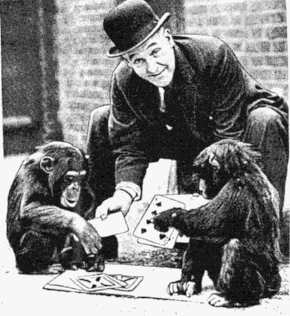
 (Martin Lewis' observations are after the picture)
(Martin Lewis' observations are after the picture)
John Philip Quinn's book FOOLS OF FORTUNE, 1892, calls Three Card Monte an ancient device of sharpers. Stephen Minch in his excellent work, FROM WITCHCRAFT TO CARD TRICKS, 1991, states on page 22 that the first description of the Monte toss and bent corner ruse appeared in Professor Hoffmann's MODERN MAGIC of 1876. This would seem to be incorrect, unless he was referring to the first description in English, because the toss is shown in Robert-Houdin's 1861 CARD-SHARPING EXPOSED. (The title is from Hoffmann's 1882 translation).
After many years of painstaking research we, THE ASSOCIATION OF INTERNATIONAL MAGICAL SPECTATORS (A.I.M.S.), are able to present here a World Exclusive. Yes, the hitherto unknown true source of this gambling scam. We have discovered that, until now unrecognised by magical historians, the game had its roots in England and was originally called Three Card Monkey. The term Monkey was derived from the Cockney Rhyming Slang term for a pack of cards. (Monkey on my back = a playing card pack.) With usage over the years the word Monkey has become debased into Monte. In the earliest version each participant received three cards.
Below you will find a rare collector's item taken from a recent issue of our newsletter, THE MAGICAL SPECTATOR. It is an authentic picture of Three Card Monkey being played in the original cockney way. Remember you saw it here first ! (Historical note: Notice the bowler hat.)
 After perusing the above, Martin Lewis, the renowned originator of The Sidewalk Shuffle, generously sent us the following abstract of his investigations on the subject:
After perusing the above, Martin Lewis, the renowned originator of The Sidewalk Shuffle, generously sent us the following abstract of his investigations on the subject:
My research shows that the Three Card Monkey was actually brought into England by sailors returning from Gibralta where they had witnessed the natives playing "Three Dead Monkeys."
In this game the locals would throw three monkeys into a pit of vipers and wager on which one would survive. This explains the mystery of why the Gibralta Monkeys are now among the top ten endangered species.
 AIMS Homepage
AIMS Homepage




